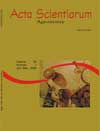<strong>Development and yield of the cotton plant under different row spacings and growth regulator application</strong> - DOI: 10.4025/actasciagron.v30i3.3546
Keywords:
plant density, mepiquat chloride, agronomic characteristics, yield
Abstract
Currently, the cultivation of the cotton plant is based on a scale production model, characterized by high yields and intensive use of fertilizers, agrochemicals and mechanization. The objective of this study was to evaluate the influence of different row spacings on cotton crops, with or without growth regulator, and their effects in crop development and yield. The experimental design was in completely randomized blocks, in a 3x3 factorial scheme with 4 replications, using three row spacings: 0.45, 0.70 and 0.90 m. Three growth regulator conditions were tested: a) application split into four stages, b) single application at 70 d.a.e, and c) no regulator application. The project was conducted in the city of Selvíria, Mato Grosso do Sul state, in November 2005. It was verified that the application of growth regulator is efficient in the limitation of plant height. The highest yield and boll mass was found in the split application of the regulator. The number of bolls and reproductive branches per plant was higher in the wider row spacings.Downloads
Download data is not yet available.
Published
2008-05-27
How to Cite
Ferrari, S., Furlani Junior, E., Ferrari, J. V., Santos, M. L., & Santos, D. M. A. dos. (2008). <strong>Development and yield of the cotton plant under different row spacings and growth regulator application</strong> - DOI: 10.4025/actasciagron.v30i3.3546. Acta Scientiarum. Agronomy, 30(3), 365-371. https://doi.org/10.4025/actasciagron.v30i3.3546
Issue
Section
Crop Production
DECLARATION OF ORIGINALITY AND COPYRIGHTS
I Declare that current article is original and has not been submitted for publication, in part or in whole, to any other national or international journal.
The copyrights belong exclusively to the authors. Published content is licensed under Creative Commons Attribution 4.0 (CC BY 4.0) guidelines, which allows sharing (copy and distribution of the material in any medium or format) and adaptation (remix, transform, and build upon the material) for any purpose, even commercially, under the terms of attribution.
2.0
2019CiteScore
60th percentile
Powered by 

2.0
2019CiteScore
60th percentile
Powered by 



















































